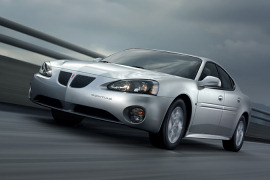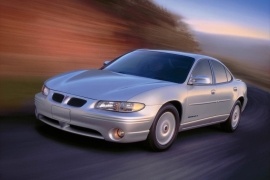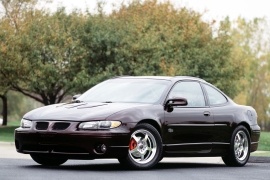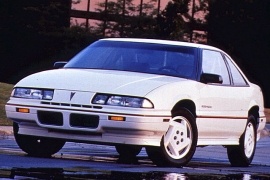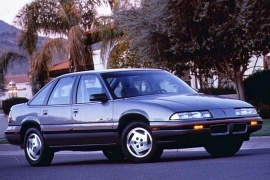PONTIAC Grand Prix Models/Series Timeline, Specifications & Photos
First production year: 1990
Engines: Gasoline
Pontiac introduced the last generation of the Grand Prix in 2003 as a deluxe sport sedan with increased interior quality and a better suspension.
The Grand Prix lineup was born in 1962 in the muscle-car era and evolved as a personal luxury car, but had more in common with Pontiac Catalina. Over time, its designation in the Pontiac lineup changed and became just another sports sedan. By 2003, GM's management decided not to offer the vehicle in a rental car spec. But that came with the cost of a drop in sales, which eventually led to the model disappearance in 2008 when the G8 replaced it for the four-door sedan and the GTO for the coupe version.
While it shared the same W-body platform from the third generation as its stablemates Chevrolet Impala/Monte Carlo and Buick LaCrosse, the Grand Prix looked sportier. Its split grille was very recognizable, while the big, triangular headlights resembled a pair of angry eyes. In the bumper, Pontiac installed wide fog lights on the outer section. The cab-rearward left the impression of a rear-wheel-drive vehicle, even though it lost that feature since 1987 when the carmaker launched the fifth generation. Its sloped rear windscreen made the car looked more like a four-door coupe than a regular sedan.
Inside, the carmaker dropped the cheap plastic dashboard and door cards from its predecessor and installed Audi-like materials. Pontiac improved even details such as door handles, gear selector, steering wheel, and buttons. Pontiac left no stone unturned and replaced or improved 80% of the car over its predecessor.
Under the hood, Pontiac still used the old pushrod 3.8-liter V-6 as the base version, upgraded with the help of a supercharger for the GTP trim-level. Both were paired with a four-speed automatic transmission.
Pontiac unleashed the seventh generation of the Grand Prix in 1997 and produced the car either as a coupe or a four-door sedan.
The carmaker continued the idea of a front-wheel driven performance vehicle able to provide enough pleasure for the one behind the wheel while still being comfortable enough for the rest of the occupants. In the four-door configuration, Pontiac offered more room for the rear-seated passengers and also installed mounting points for child seats.
With a design signed by John Manoogian II and Tom Keams, the Grand Prix coupe sported fluid, organic lines on its bodywork. The front fascia featured slim headlights swept on the sides, with the blinkers on the front fenders. Customers and brand fans could easily recognize the specific Pontiac split grille at the front, incorporated into the wrap-around plastic bumper. On the lower apron, the automaker installed a pair of round fog lights on the outer sides. For the four-door version, the Grand Prix sported a curved ascending beltline that continued behind the C-pillars. Due to the rear doors' shape, the automaker had to split the windows. At the back, the raked-forward windscreen and the short deck created a surprisingly sporty look for the four-door sedan.
Inside, on the dashboard, the instrument cluster sported a four-dial setup, with a large tachometer and speedometer flanked on the sides by the fuel gauge on the left and the temperature on the right. The front bucket seats were designed mostly for comfort. At the same time, there was enough room in the back for three passengers thanks to the wide seat bench. In addition, due to the long wheelbase, there was enough kneeroom for them.
But such a sporty-looking vehicle deserved a better engine. In 1996, when the car was introduced, it was fitted with a 3.1-liter V6 for the base models and a new 3.8-liter with the same configuration from GM's parts bin. All versions were paired with a four-speed auto fitted as standard.
In the summer of '96, Pontiac unleashed the seventh generation of the Grand Prix lineup, which consisted of a sedan and a coupe, and targeted customers who looked for American muscles in a European format.
The new model came with the same idea of a front-wheel driven performance car that could provide enough thrills but also be good enough for school runs. Pontiac made the Grand Prix with either four or two doors, the latter being made for those who didn't really need back seats anyway. Moreover, the improved second generation of the W-body platform soon became appreciated by customers.
With a design signed by John Manoogian II and Tom Keams, the Grand Prix coupe sported fluid, organic lines on its bodywork. The front fascia featured slim headlights swept on the sides, with the blinkers on the front fenders. Customers and brand fans could easily recognize the specific Pontiac split grille at the front, incorporated into the wrap-around plastic bumper. On the lower apron, the automaker installed a pair of round fog lights on the outer sides. The car's profile revealed a waved shape with a slight raise of the beltline on its connection with the C-pillars. At the back, the raked-forward windscreen and the short deck created a sporty look for the car.
Inside, the automaker installed bolstered front seats and a bench profiled for two in the back. On the dashboard, the instrument cluster sported a four-dial setup, with a large tachometer and speedometer flanked on the sides by the fuel gauge on the left and the temperature on the right. On the center console, Ponitac installed the sound system and the controls for the HVAC unit. Atop the center stack, Pontiac installed a so-called "driver information center" with data collected from the onboard computer. It even showed the tire pressure.
But such a sporty-looking coupe deserved a better engine. In 1996, when the car was introduced, it was fitted with a 3.1-liter V6 for the base models and a new 3.8-liter with the same configuration from GM's carts. All versions were paired with a four-speed auto fitted as standard.
In 1990, Pontiac ranked third in U.S. car sales, and it described itself as an exciting brand, confirmed partially by the Grand Prix Coupe model.
Pontiac was one of the most successful American car brands for decades. Models such as the Trans Am or the Grand Prix were on the sporty side of the brand. Starting with 1988, Pontiac installed the new front-wheel-drive W-Body 1st Gen platform shared with the Oldsmobile Cutlass Supreme and the Chevrolet Lumina. But people more often saw the Grand Prix Coupe on the track days than in front of the Opera. In 1990, the carmaker refreshed the two-door vehicle.
The design team made the car's front fascia with a tilted nose and narrow headlights. On the lower side of the bumper, Pontiac installed its specific split grille with a vertical slat in the middle. Its long doors allowed a comfortable ingress and egress for all passengers. At the back, a flat trunk lid and corner-mounted taillights completed the car's sporty look. For the Turbo version, an aerodynamic bodywork cladding package and functional hood louvers screamed for attention and became highly controversial, together with the car's golden light-alloy wheels.
Inside, Pontiac dropped the digital instrument panel and installed an analog one with two large dials for the speedometer and tachometer, plus another four gauges for additional information. At the front, the Grand Prix featured two power-adjustable bucket seats. The carmaker placed two individual seats in the back, divided by a fixed center armrest instead of a bench and a folding armrest.
Under the hood, Pontiac replaced the former 2.8-liter V-6 with a new 3.1-liter powerplant, with or without a turbocharger. The turbocharged version provided almost 80 ponies more than its non-turbocharged version. Both versions sent their power to the ground via a four-speed automatic transmission.
The Grand Prix was already a classic contender in the sport sedan market and was one of the carmaker's best-selling products.
Pontiac was one of the most successful American car brands for decades. Models such as the Trans Am or the Grand Prix were on the sporty side of the brand. Starting with 1988, Pontiac installed the new front-wheel-drive W-Body 1st Gen platform shared with the Oldsmobile Cutlass Supreme and the Chevrolet Lumina. Just two years after the car's launch, Pontiac introduced a refreshed version for the four-door sports sedan.
The design team made the car's front fascia with a tilted nose and narrow headlights. On the lower side of the bumper, Pontiac installed its specific split grille with a vertical slat in the middle. Its sides revealed a three-window profile with a large triangular glass area behind the rear doors. At the back, a flat trunk lid and corner-mounted taillights completed the car's sporty look.
Inside, Pontiac dropped the digital instrument panel and installed an analog one with two large dials for the speedometer and tachometer, plus another four gauges for additional information. At the front, the Grand Prix featured two power-adjustable bucket seats.
Pontiac offered the four-door Grand Prix in two trim levels: LE or STE. The former was powered by a 2.3-liter inline-four, while the STE received a 140 hp 3.1-liter powerplant. Both versions sent their power to the ground via a four-speed automatic transmission.
